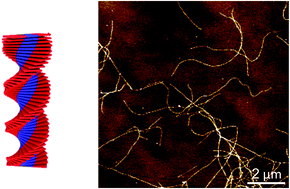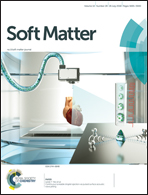Hydrogen-bonding-directed helical nanofibers in a polythiophene-based all-conjugated diblock copolymer†
Abstract
One-dimensional (1D) helical nanofibers were prepared through the self-assembly of an achiral all-conjugated diblock copolymer, poly(3-hexylthiophene)-b-poly[3-(6-hydroxyl)hexylthiophene] (P3HT-b-P3HHT) in an aged pyridine solution. Such helical nanofibers were formed by the π–π interaction between planar rigid polythiophene backbones cooperating with the hydrogen-bonding interactions between the polar hydroxyl groups of the side chains of polythiophenes. Intriguingly, the Young's modulus of such helical fibers is as high as ∼5.16 GPa, which is about twice that of P3HT films characterized by the peak force quantitative nanomechanical (PF-QNM) method. Furthermore, for the first time, we report that such helical fibers based on all-conjugated polythiophenes exhibited a relatively high field-effect mobility of 0.03472 cm2 V−1 s−1. This work provides a promising approach to craft crystalline helical nanostructures based on polythiophenes possessing both superior mechanical and good charge transport properties, which has great potential for application in other π-conjugated systems or building blocks for complex superstructures, and mechanical and optoelectronic devices.



 Please wait while we load your content...
Please wait while we load your content...